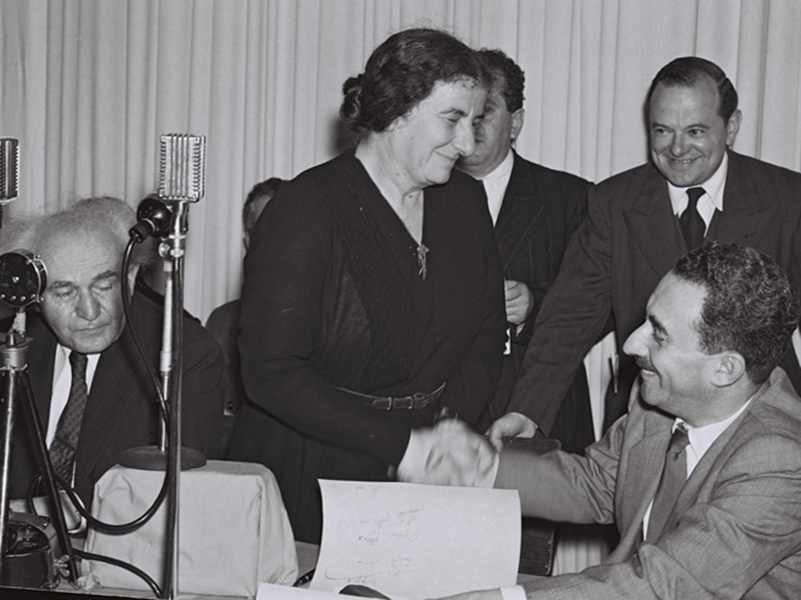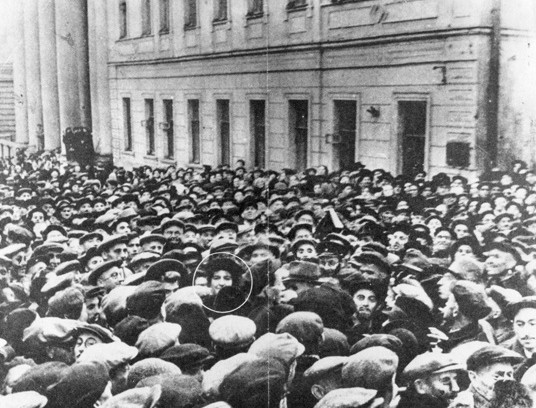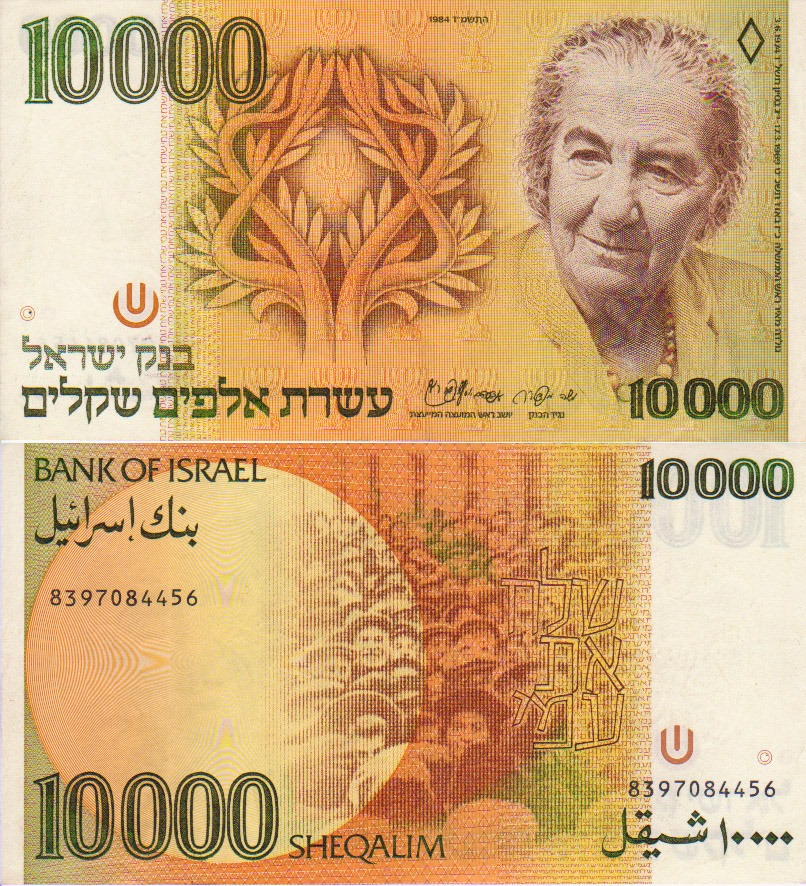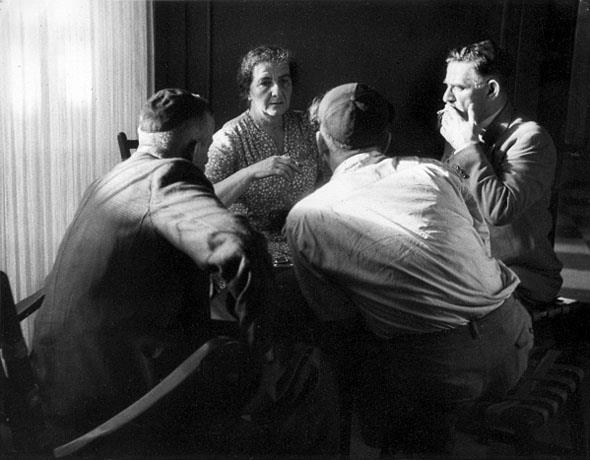She had plenty of reasons not to go to Moscow. Israel was less than a month old, the War of Independence was raging, and she was in the middle of a fundraising campaign in the United States. She had left Kiev when it was still part of the Russian Empire. She was 8 years old when her family emigrated to the United States in search of livelihood and a new life. She didn’t even speak Russian. And, in general, there was finally an independent Jewish state and she wanted to be in Israel.
On the other hand, she was an obedient and loyal emissary. So, following a few phone conversations with the Foreign Minister, Moshe Sharet, Golda Meir agreed to become the State of Israel’s ambassador to the Soviet Union. In her autobiography, My Life, she admits that she had hoped to return to Israel and try and persuade Sharet and Ben-Gurion to change their decision. But her appointment was announced in the first week of June.
However, Golda only made it to Moscow on September 2nd because on her last day in New York, she was injured in a traffic accident. She broke her leg and was hospitalized for several weeks. “I had hoped to get some rest during that period, but cameras and reporters were all over me,” she later wrote. In 1948, there were not many women ambassadors. And a women ambassador from a small country engaged in a war of a survival, who was about to serve in the Soviet Union – was a big deal. Golda could, of course, have refused, but she felt that that kind of publicity would have a positive impact on Israel’s image in the world. Consequently, she agreed to every interview request she received.

Besides the reporters, people from Israel were also giving her a hard time. There were rumors that Golda was fabricating her condition because she simply did not want to leave. In the end, she was forced to ask the doctors to discharge her so she could return to Israel. She still had hope that her appointment could be canceled, but her efforts were in vain. To sweeten the pill, Sharet offered to send her daughter, Sarah, and her son-in-law, Zechariah, to Moscow as members of the diplomatic staff.
To ensure Golda would make a favorable impression, comme il fault – in line with etiquette – an entire wardrobe was purchased for her. It could not have been more different from the unostentatious and very basic clothes she was used to wearing on the kibbutz where she lived. Soon after that, on a rainy morning at the beginning of September, the Israeli delegation landed in Moscow.
Because the ambassador’s residence was not yet ready, the Israelis were put up in a hotel. “A stern looking woman was stationed on every floor of the hotel, whose job was to stand guard and deliver the keys to the rooms. But we were sure that she also reported what we were doing to the KGB.”
After presenting her credentials to Vyacheslav Molotov, the Soviet Foreign Minister, Golda embarked on her most important mission: renewing the ties with Soviet Jewry. “From the outset, our rooms were open to visitors. I had hoped that local Jews would come and visit us, but that did not happen. We were visited by reporters, Jews and non-Jews from the other embassies, Jewish businessmen from other countries – but not a single Soviet citizen, whether Jewish or not. ”

On their first Sabbath in the Soviet Union, the entire staff of the Israeli embassy went to the Great Synagogue in Moscow. It was the first time in many years that people wearing a tallit (prayer shawl) and carrying a prayer book could be seen walking in the streets of the city. Around 150 people were waiting next to the synagogue, all of them elderly, and they were very surprised to see the Israelis. In addition to the traditional service and blessings for the Soviet government, the rabbi also recited a blessing for the health of Golda Meir. “I was very surprised. I was sitting in the women’s section, and when the rabbi mentioned my name, everyone turned around to look at me. It was as if they wanted to remember me. No one said a word.”
But what happened on the way back to the hotel caused Golda to break out in tears. An elderly man who passed by her touched her arm, as if by chance. Then he whispered to her: “I’ll walk ahead of, and you follow.” When they reached the hotel, he suddenly turned to her and quietly quoted from the Shehecheyanu blessing: “Blessed are You, our God…who has granted us life, sustained us and enabled us to reach this occasion.”
That year Rosh Hashanah fell on October 3, 1948, which was exactly one month after Golda Meir arrived in Moscow. “We put on our best clothes and went to the synagogue. We were told that unlike the regular Sabbaths, a larger crowd than usual was expected. But the closer we got, the harder it was to recognize the place. The street was full of people of all different ages: Red Army officers, senior citizens, teens, babies held on their parents’ arms. Tens of thousands of people were there. At first, I couldn’t grasp what had happened or even who they were. And then it dawned on me. These good and brave Jews had come to demonstrate their sense of kinship and to celebrate the establishment of the State of Israel together with us. They surrounded me, just about trampling me, and nearly picked me up in their hands, while calling out my name over and over again.”

David Havkin, aged 18, was in the huge crowd of Jews who had come to see Golda that night. An amateur photographer, Havkin climbed up on the roof of one of the buildings so he could get a better view and take some photographs. One of them is the famous picture that was printed on the old yellow NIS 10,000 bill, and after that on the new NIS 10 bill, which was in circulation until the middle of the 1990’s. The picture appears next to Golda’s portrait and the words in Hebrew: “Let My People Go.”
The significance of that momentous gathering cannot be understood without mentioning the bitter plight of the Jews under Soviet rule. When building a new world, you discard the fragments of the old world and, together with them, religious rituals and the rich Yiddish culture. You have to be loyal to the Soviet state, and that loyalty has to be exclusive.
The display of love towards Golda, coupled with the excitement that took hold of the worshippers at the Great Synagogue in Moscow during the Ne’ila service that concludes Yom Kippur, which includes the words “Next year in Jerusalem,” did not go unnoticed by the Soviet authorities. Stalin was absolutely unwilling to accept the revival of the Zionist movement in the Soviet Union, and before long Zionism became a dirty word in the Soviet space.

A few days before Rosh Hashanah, and not coincidentally, the reporter Ilya Ehrenberg wrote an article in the newspaper. A Jew himself, but one whose loyalty to the regime was undisputed, he claimed that if not for Stalin, the Jewish state would not have been
founded. However, he also made of point of saying that the State of Israel is needed only by Jews who live in capitalist countries, countries where antisemitism runs rampant. In contrast, in the Soviet Union, antisemitism cannot exist because everyone is equal.
During her stay in Moscow, Golda also met with Ehrenberg, who tried talking Russian with her. And when she told him that she didn’t speak the language and suggested that they converse in English, Ehrenberg remarked scornfully that he hates Jews who were born in Russia but don’t speak the language. Golda retaliated by saying that she pities Jews who don’t speak Hebrew, or at least Yiddish.
Golda completed her service as ambassador to the Soviet Union seven months later, after being asked by David Ben-Gurion to join his government as Labor Minister. In retrospect, it’s hard to know whether she could have predicted the sanctions that would be imposed on the Soviet Jews who had come to greet her during the High Holidays at the Moscow synagogue. But, for a fact, those gatherings triggered a chain of tragic events. To start with, Stalin dismantled the Jewish Anti-Fascist Committee, whose members were accused of cosmopolitanism and conspiring with the West. They were convicted in show trials and eventually executed. After that came the so-called Doctors’ Plot, whose aim was to annihilate high-ranking Jewish doctors, who were accused of plotting to kill none other than Stalin himself. The father of the nation had a few more ideas for solving the ‘Jewish question’ to his satisfaction, but the dictator died on March 5, 1953. The persecution of the Jews by the Soviet regime continued after his death. To survive, many Jews chose to conceal their identity for years, or even erase it altogether, and did not pass on their bond with Judaism and the State of Israel to the next generations.